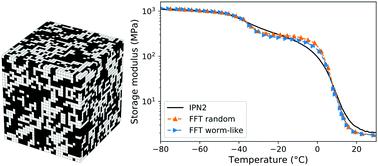当前位置:
X-MOL 学术
›
Soft Matter
›
论文详情
Our official English website, www.x-mol.net, welcomes your feedback! (Note: you will need to create a separate account there.)
Linear viscoelasticity of an acrylate IPN, analysis and micromechanical modeling
Soft Matter ( IF 3.4 ) Pub Date : 2021-06-28 , DOI: 10.1039/d1sm00808k Julie Diani 1 , Éléonore Strauch-Hausser 1
Soft Matter ( IF 3.4 ) Pub Date : 2021-06-28 , DOI: 10.1039/d1sm00808k Julie Diani 1 , Éléonore Strauch-Hausser 1
Affiliation

|
An amorphous acrylate interpenetrated polymer network (IPN) was made in the laboratory and tested by dynamic mechanical analysis. Using frequency sweep tests, it was shown that the time–temperature superposition principle applies to the double network. Moreover, a generalized Maxwell model with forty Maxwell branches successfully reproduced the material's linear viscoelasticity. Using temperature sweep tests, the linear viscoelasticity of the IPN has been estimated using micromechanics, applying both mean-field homogenization models and fast Fourier transform (FFT)-based homogenization techniques. This modeling effort allowed discussing the mechanical interactions of the simple network. The microstructure of a second network, defined by a self-avoiding random walk, embedded in a continuous medium, in place of the first network, is shown to provide with satisfactory estimates of the linear viscoelasticity of the IPNs.
中文翻译:

丙烯酸酯 IPN 的线性粘弹性、分析和微机械建模
在实验室中制备了无定形丙烯酸酯互穿聚合物网络 (IPN),并通过动态力学分析进行了测试。使用频率扫描测试表明,时间-温度叠加原理适用于双网络。此外,具有四十个麦克斯韦分支的广义麦克斯韦模型成功地再现了材料的线性粘弹性。使用温度扫描测试,IPN 的线性粘弹性已使用微力学估计,应用平均场均化模型和基于快速傅立叶变换 (FFT) 的均化技术。这种建模工作允许讨论简单网络的机械相互作用。第二个网络的微观结构,由自我避免的随机游走定义,嵌入在连续介质中,代替第一个网络,
更新日期:2021-07-21
中文翻译:

丙烯酸酯 IPN 的线性粘弹性、分析和微机械建模
在实验室中制备了无定形丙烯酸酯互穿聚合物网络 (IPN),并通过动态力学分析进行了测试。使用频率扫描测试表明,时间-温度叠加原理适用于双网络。此外,具有四十个麦克斯韦分支的广义麦克斯韦模型成功地再现了材料的线性粘弹性。使用温度扫描测试,IPN 的线性粘弹性已使用微力学估计,应用平均场均化模型和基于快速傅立叶变换 (FFT) 的均化技术。这种建模工作允许讨论简单网络的机械相互作用。第二个网络的微观结构,由自我避免的随机游走定义,嵌入在连续介质中,代替第一个网络,



























 京公网安备 11010802027423号
京公网安备 11010802027423号